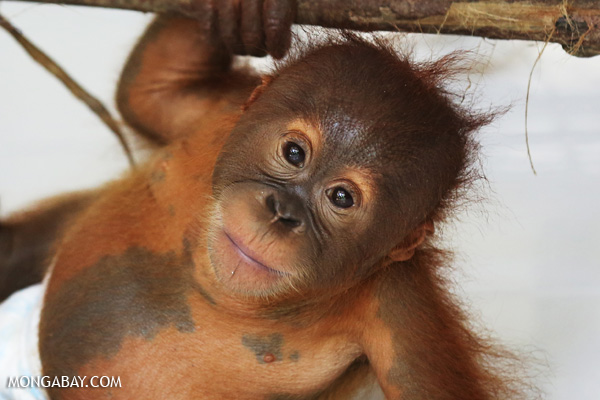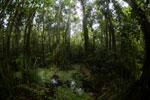Critically endangered orangutans threatened by palm oil, wood fiber, logging, poaching; populations fragment and dwindle as habitat is lost
Orangutans have long been the reluctant spokesanimal for Indonesia’s rampant deforestation. The great ape is native exclusively to the islands of Borneo and Sumatra — two regions that have seen the brunt of Indonesia’s recent forest destruction due primarily to logging and plantation development. Although there are anywhere from 45,000 to 69,000 Bornean orangutans (Pongo pygmaeus)remaining in the wild, the Sumatran species (Pongo abelii) numbers only about 7,300 according to a 2004 survey, and is dwindling further every year.
“One of the major threats to the Sumatran orangutan is habitat loss due to the conversion of natural forests for the benefit of crop cultivation and plantation development,” said Chairul Saleh, the species coordinator for the World Wildlife Fund (WWF) Indonesia.

A baby Sumatran orangutan at an orphanage for orangutans whose mothers died due to habitat loss, poaching, and other causes. Photo by Rhett A. Butler.
Having recently had the distinction of passing Brazil as the country with the world’s highest rate of deforestation, with more than two million hectares lost in 2012 alone, according to data from Global Forest Watch (GFW). Indonesia’s last remaining forests and the animals that inhabit them are constantly under threat. The critically endangered Sumatran orangutan is one of the most vulnerable species in the whole country.
The primate’s main habitat occurs in an area known as the Leuser Ecosystem — a 2.5 million-hectare area that straddles Aceh and North Sumatra. It is here that the last remaining populations of 1,000 or more orangutans live, according to the Sumatran Orangutan Conservation Program (SOCP).
Although not as recently heavily deforested as much of the rest of Indonesia, Aceh lost nearly 400,000 hectares of forest between 2001 and 2013, according to GFW. In that same timespan, North Sumatra lost nearly 900,000 hectares of forest. In addition, GFW maps show that dozens of logging concessions and oil palm plantations overlap with the Sumatran orangutan’s main habitats.
A prime example of this can be found in the Tripa peat swamps, on the west coast of Aceh. The area covers 61,803 hectares and represents one of six remaining habitats for the orangutan, according to the Orangutan Project. Two years ago, palm oil concessions were granted in the protected peat swamps — in the heart of the Leuser Ecosystem — despite being home to one of the last large populations of Sumatran orangutans.
In addition, other, more remote orangutan populations on the island are facing similar threats. Though most Sumatran orangutans live in or near the Leuser Ecosystem, a small population of orangutans can be found south of North Sumatra’s Lake Toba, in the Batang Toru forest complex. It is home to a genetically distinct group of orangutans. Only 25 percent of the forest block is protected under Indonesian law.
“The primary everyday threats are illegal logging and hunting,” said Matthew Nowak, the director of the biodiversity monitoring unit at the SOCP. “About 135,000 locals live in areas adjacent to the forest, [and] the majority of these people make a livelihood via agro-forestry.”

Sumatran orangutans are found almost exclusively in Aceh and North Sumatra. Together, the two states lost nearly 1.3 million hectares of land between 2001 and 2013 – or about 13 percent of their total forest cover. Map courtesy of Global Forest Watch. Click to enlarge.

Logging, palm oil, and wood fiber concessions drive the clearing of native trees, whittling down what’s left of the region’s intact forests. Orangutans are also highly threatened by illegal logging and poaching. Map courtesy of Global Forest Watch. Click to enlarge.
The remaining Batang Toru area spans roughly 134,000 hectares, and much of the area has been chalked off for various plantation concessions. Sun bears, tapirs and Sumatran tigers can also be found there. SOCP is working to change the status of the forested area from “production forest” to “protected forest” in order to help protect the fragile population of orangutans and other wildlife there.
“To help facilitate this process, we gather scientific information about the local flora and fauna and highlight its biological importance, collaborate and foster relationships with all stakeholders and develop public awareness about Batang Toru,” Nowak said.
WWF Indonesia is also working to monitor and assist Sumatran orangutan populations in Aceh in North Sumatra. Similar to projects it has employed in Borneo that focused on connecting fragmented orangutan populations, WWF is advocating for spatial development policies to protect the endangered species habitats.
“In Aceh and North Sumatra, currently WWF Indonesia encourages corridor management strategies in the habitats of four endangered species — namely orangutans, tigers, elephants and rhinos — especially in fragmented areas,” Chairul told mongabay.com. The organization also works with likeminded organizations to thwart further deforestation by conglomerates like Sinar Mas, according to its website.
Habitat connectivity is essential for the survival of orangutans, as they mostly dwell in trees and are hesitant to descend to open ground in areas that have been logged. WWF describes the creatures as “almost exclusively arboreal,” and asserts that females in particular almost never travel on ground. This makes deforestation particularly devastating for these orangutans.
But as Aceh and other provinces in Sumatra continue to ramp up their extractive practices, plant palm oil and log, the orangutans’ habitat will continue to shrink, marooning the few populations left in smaller and smaller islands of trees.
Even as Nowak works to save Batang Toru and its orangutans, he can’t help but express pessimism that efforts to protect the area will be effective given the forest’s strategic position.
“While most of the area is very rugged, and therefore difficult to exploit, continued losses of lowland forest in Sumatra will eventually make the hill/submontane forests of Batang Toru the only option for exploitation,” he said.
Citations:
- Singleton, I., Wich, S.A. & Griffiths, M. 2008. Pongo abelii. The IUCN Red List of Threatened Species. Version 2014.2. . Downloaded on 16 September 2014.
- Hansen, M. C., P. V. Potapov, R. Moore, M. Hancher, S. A. Turubanova, A. Tyukavina, D. Thau, S. V. Stehman, S. J. Goetz, T. R. Loveland, A. Kommareddy, A. Egorov, L. Chini, C. O. Justice, and J. R. G. Townshend. 2013. “UMD Tree Cover Loss and Gain Area.” University of Maryland and Google. Accessed through Global Forest Watch on 16 September 2014.
}}
Related articles
Why are great apes treated like second-class species by CITES?
(09/11/2014) The illegal trade in live chimpanzees, gorillas, bonobos and orangutans showed no signs of weakening in the first half of 2014—and may actually be getting worse—since the Great Apes Survival Partnership (GRASP) published the first-ever report to gauge the global black market trade in great apes in 2013.
20 orangutan pictures for World Orangutan Day

(08/19/2014) August 19 is World Orangutan Day, a designation intended to raise awareness about the great red ape, which is threatened by habitat loss, the pet trade, and hunting. Once distributed across much of southeast Asia, today orangutans are only found on the islands of Borneo and Sumatra. Both species of orangutan — the Sumatran and the Bornean — are considered endangered.
Aceh’s largest peat swamp at risk from palm oil
(08/11/2014) Oil palm plantations and other developments are threatening Rawa Singkil Wildlife Preserve—Aceh’s largest peat swamp, and home to the densest population of Sumatran orangutan in the Leuser Ecosystem. The lack of clear boundaries, and construction of roads bisecting the area has fostered encroachment by local and outside entrepreneurs, including some former local officials, reports Abu Hanifah Lubis, Program Manager of Yayasan Leuser Internasional (YLI).

(07/21/2014) After more than four and a half years of camera trap footage, the results are encouraging: 36 mammal species, of which more than half are legally protected, are prospering in this most surprising of spots: an oil palm plantation in the province of East Kalimantan in Indonesian Borneo.
What is peat swamp, and why should I care?

(07/20/2014) Long considered an unproductive hindrance to growth and development, peat swamp forests in Southeast Asia have been systematically cleared, drained and burned away to make room plantations and construction. Now, as alternating cycles of fires and flood create larger development problems, while greenhouse gas emissions skyrocket, it is time to take a closer look at peat, and understand why clearing it is a very bad idea.
30% of Borneo’s rainforests destroyed since 1973

(07/16/2014) More than 30 percent of Borneo’s rainforests have been destroyed over the past forty years due to fires, industrial logging, and the spread of plantations, finds a new study that provides the most comprehensive analysis of the island’s forest cover to date. The research, published in the open-access journal PLOS ONE, shows that just over a quarter of Borneo’s lowland forests remain intact.
Despite early headwinds, Indonesia’s biggest REDD+ project moves forward in Borneo

(06/26/2014) Just over a year ago, the Indonesian government officially approved the country’s first REDD+ forest carbon conservation project: Rimba Raya, which aims to protect more than 64,000 hectares of peat forest in Central Kalimantan. The approval came after years of delays from the Ministry of Forestry and a substantial reduction in the project’s concession area. But InfiniteEarth, the firm behind the project, pressed on. Now a year later, Rimba Raya’s is not only still in business, but is scaling up its operations.
Broken promises no more? Signs Sabah may finally uphold commitment on wildlife corridors

(06/23/2014) Five years ago an unlikely meeting was held in the Malaysian state of Sabah to discuss how to save wildlife amid worsening forest fragmentation. Although the meeting brought together longtime adversaries—conservationists and the palm oil industry—it appeared at the time to build new relationships and even point toward a way forward for Sabah’s embattled forests.
- Hansen, M. C., P. V. Potapov, R. Moore, M. Hancher, S. A. Turubanova, A. Tyukavina, D. Thau, S. V. Stehman, S. J. Goetz, T. R. Loveland, A. Kommareddy, A. Egorov, L. Chini, C. O. Justice, and J. R. G. Townshend. 2013. “UMD Tree Cover Loss and Gain Area.” University of Maryland and Google. Accessed through Global Forest Watch on 16 September 2014.